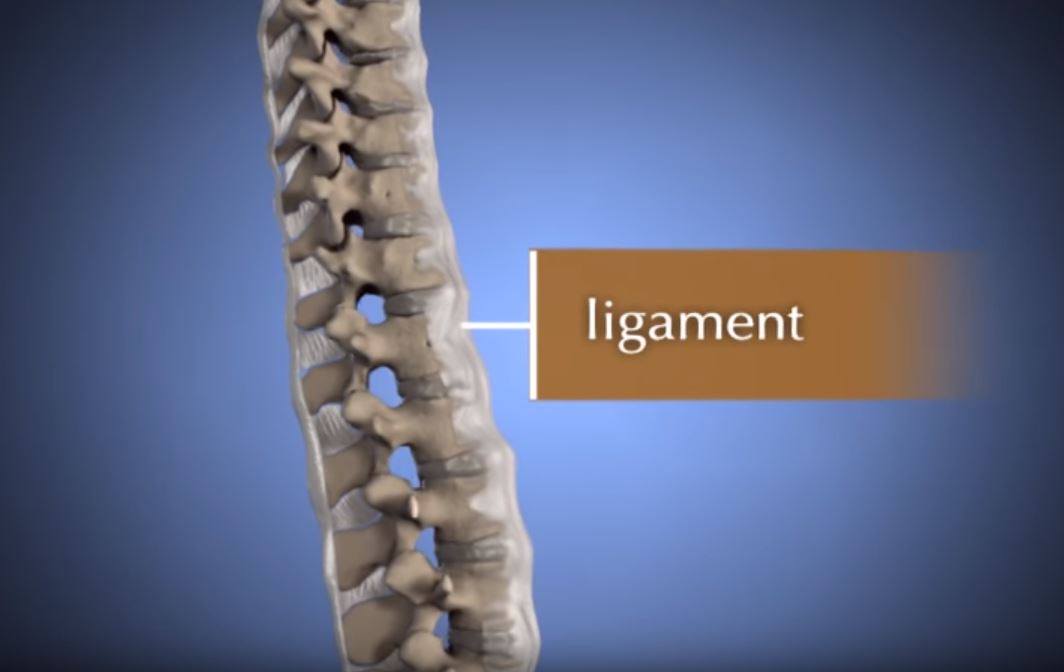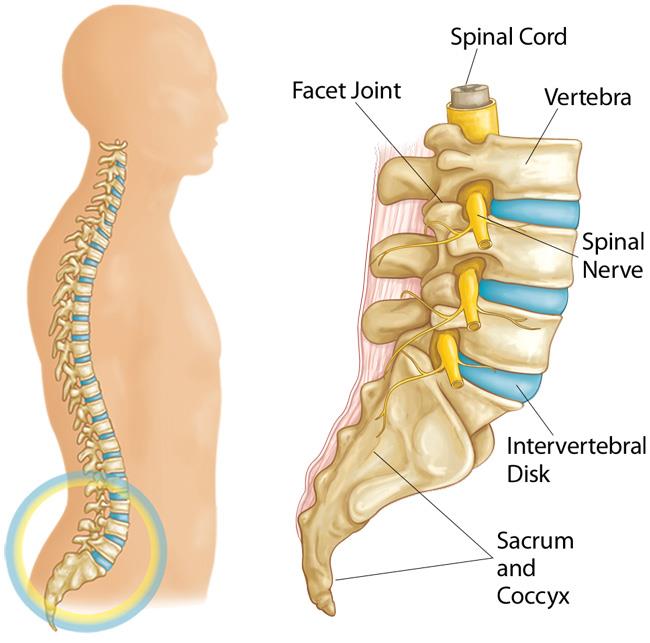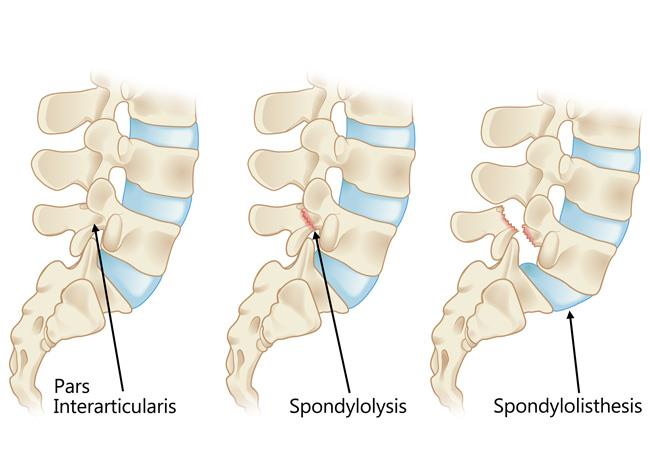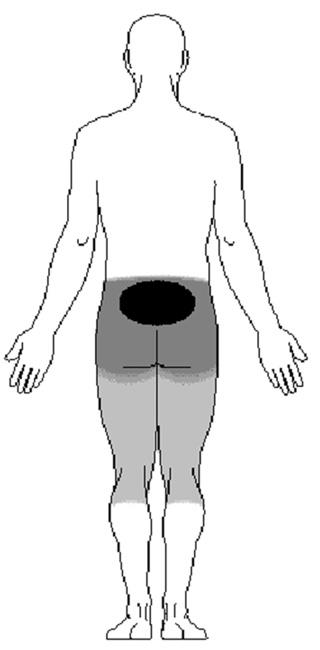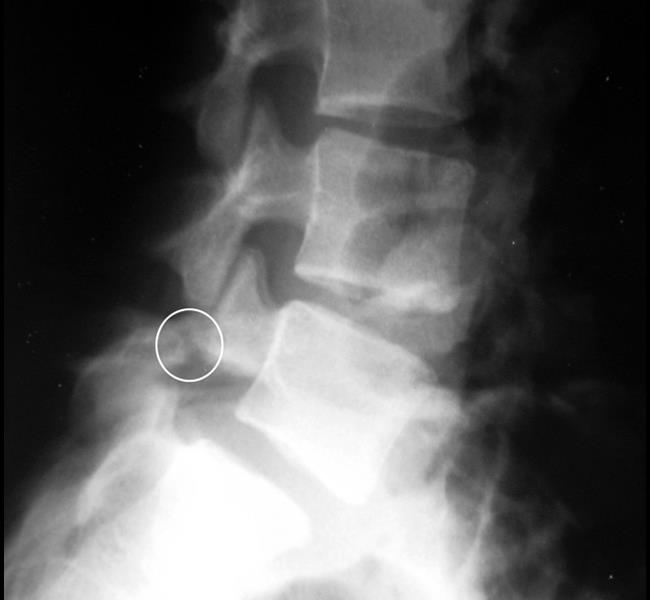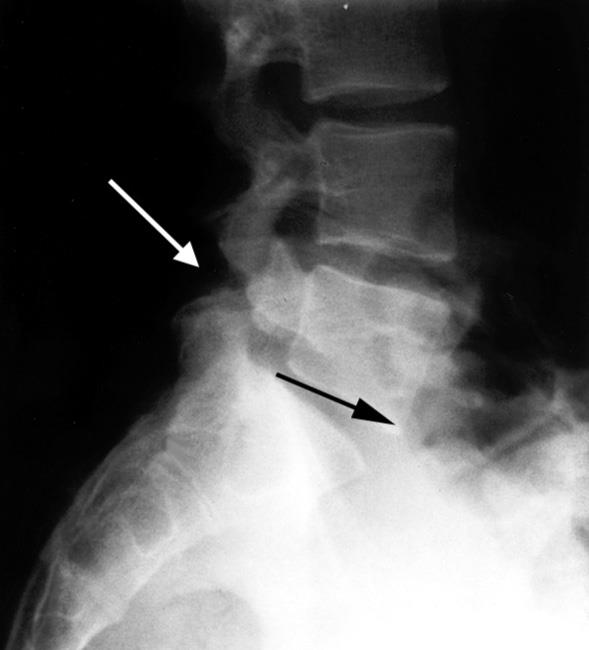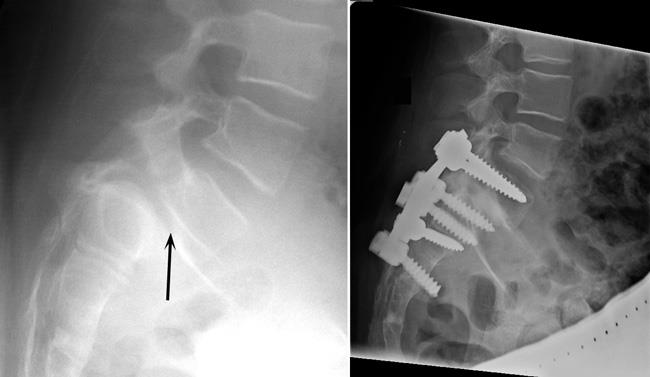Diseases & Conditions
Spondylolysis and Spondylolisthesis
Spondylolysis (spon-dee-low-lye-sis) and spondylolisthesis (spon-dee-low-lis-thee-sis) are common causes of low back pain in children and adolescents.
Spondylolysis is a weakness or stress fracture in one of the vertebrae, the small bones that make up the spinal column. This condition or weakness can occur in up to 5% of children as young as age 6 with no known injury. A stress fracture can occur in adolescents who participate in sports that involve repeated stress on the lower back, such as gymnastics, football, and weightlifting. In some cases, the stress fracture weakens the bone so much that it is unable to maintain its proper position in the spine — and the vertebra starts to shift or slip out of place. This condition is called spondylolisthesis.
Anatomy
Your spine is made up of 24 small rectangular-shaped bones, called vertebrae, which are stacked on top of one another. These bones connect to create a canal that protects the spinal cord.
The five vertebrae in the lower back comprise the lumbar spine.
Other parts of your spine include:
Spinal cord and nerves. These "electrical cables" travel through the spinal canal carrying messages between your brain and muscles. Nerve roots branch out from the spinal cord through openings in the vertebrae.
Facet joints. Between and behind adjacent vertebra are small joints that provide stability and help to control the movement of the spine. The facet joints work like hinges, and run in pairs down the length of the spine on each side.
Intervertebral disks. Between the vertebrae are flexible intervertebral disks. These disks are flat and round and about a half-inch thick. Intervertebral disks cushion the vertebrae and act as shock absorbers when you walk or run.
Description
Spondylolysis and spondylolisthesis are different spinal conditions — but they are often related to each other.
Spondylolysis
In spondylolysis, a crack or stress fracture develops through the pars interarticularis (pars fracture). The pars interarticularis is a small, thin portion of the vertebra that connects the upper and lower facet joints.
Most commonly, this fracture occurs in the fifth vertebra of the lumbar spine, although it sometimes occurs in the fourth lumbar vertebra. Fracture can occur on one side or both sides of the bone.
The pars interarticularis is the weakest portion of the vertebra. For this reason, it is the area most vulnerable to injury from the repetitive stress and overuse that characterize many sports.
Spondylolysis can occur in people of all ages without injury or sports participation.
Often, patients with spondylolysis will also have some degree of spondylolisthesis.
Spondylolisthesis
In spondylolisthesis, the fractured pars interarticularis separates, allowing the injured vertebra to shift or slip forward on the vertebra directly below it. In children and adolescents, this slippage most often occurs during periods of rapid growth — such as an adolescent growth spurt.
Doctors commonly describe spondylolisthesis as either low grade or high grade, depending upon the amount of slippage. A high-grade slip occurs when more than 50% of the width of the fractured vertebra slips forward on the vertebra below it. Patients with high-grade slips are more likely to experience significant pain and nerve injury and to need surgery to relieve their symptoms and prevent further deterioration.
Cause
Overuse
Both spondylolysis and spondylolisthesis are more likely to occur in young people who participate in sports that require frequent overstretching (hyperextension) of the lumbar spine — such as gymnastics, football, and weightlifting. Over time, this type of repetitive activity can weaken the pars interarticularis, leading to fracture and/or slippage of a vertebra.
Genetics
The lower lumbar spine has a risk of developing stress weakness at the location of a spondylolysis in all children, adolescents, and adults who walk upright. Doctors believe that some people may be born with vertebral bone that is thinner than normal — and this may make them more vulnerable to fractures.
Symptoms
In many cases, patients with spondylolysis and spondylolisthesis do not have any obvious symptoms. The conditions may not even be discovered until an X-ray is taken for an unrelated injury or condition.
When symptoms do occur, the most common symptom is lower back pain. This pain may:
- Feel similar to a muscle strain
- Radiate to the buttocks and back of the thighs
- Worsen with activity and improve with rest
In patients with spondylolisthesis, muscle spasms may lead to additional signs and symptoms, including:
- Back stiffness
- Tight hamstrings (the muscles in the back of the thigh)
- Difficulty standing and walking
Spondylolisthesis patients who have severe or high-grade slips may have tingling, numbness, or weakness in one or both legs. These symptoms result from pressure on the spinal nerve root as it exits the spinal canal near the fracture.
Doctor Examination
Physical Examination
Your child's doctor will begin by taking a medical history and asking about your child's general health and symptoms. They will want to know if your child participates in sports. Children who participate in sports that place excessive stress on the lower back are more likely to have a diagnosis of spondylolysis or spondylolisthesis.
Your child's doctor will carefully examine your child's back and spine, looking for:
- Areas of tenderness
- Limited range of motion
- Muscle spasms
- Muscle weakness
The doctor will also observe your child's posture and gait (the way they walk). In some cases, tight hamstrings may cause a patient to stand awkwardly or walk with a stiff-legged gait.
Imaging Tests
Imaging tests will help confirm the diagnosis of spondylolysis or spondylolisthesis.
X-rays. X-rays provide images of dense structures, such as bone. The doctor may order X-rays of your child's lower back from a number of different angles to look for a stress fracture and to view the alignment of the vertebrae.
If x-rays show a crack or stress fracture in the pars interarticularis portion of the fourth or fifth lumbar vertebra, it is an indication of spondylolysis.
If the fracture gap at the pars interarticularis has widened and the vertebra has shifted forward, it is an indication of spondylolisthesis. An X-ray taken from the side will help your doctor determine the amount of forward slippage.
Computed Tomography (CT) Scans. Computed tomography combines X-ray with computer technology to produce more detailed images than plain X-rays. CT scans can help your child's doctor learn more about the fracture or slippage and can be helpful in planning treatment. Because there is more radiation exposure with CT scans than with regular X-rays, however, your child's doctor may not routinely order this test.
In some cases, a spondylolysis may be discovered in the spine of some teenagers and children when they undergo a CT scan for unrelated reasons, such as abdominal pain or after an accident.
Single Photo Emission Computed Tomography (SPECT) scans. A SPECT scn uses a small amount of radioactive material to identify areas of increased bone activity. When CT scans are not available, a SPECT scan can identify a spondylolysis. This test is no longer used very often, however.
Magnetic Resonance Imaging (MRI) Scans. An MRI scan provides better images of the body's soft tissues than an X-ray. An MRI can help your child's doctor determine if there is early degeneration of the intervertebral disks between the vertebrae or if a slipped vertebra is pressing on spinal nerve roots. It can also help the doctor determine if there is injury to the pars interarticularis before it can be seen on X-ray.
Treatment
The goals of treatment for spondylolysis and spondylolisthesis are to:
- Reduce pain
- Allow a recent pars fracture to heal
- Return the patient to sports and other daily activities
Nonsurgical Treatment
For most patients with spondylolysis and low-grade spondylolisthesis, back pain and other symptoms will improve with nonsurgical treatment.
Nonsurgical treatment may include:
Rest. Avoiding sports and other activities that place excessive stress on the lower back for a period of time can often help improve back pain and other symptoms.
Nonsteroidal anti-inflammatory drugs (NSAIDs). NSAIDs such as ibuprofen and naproxen can help reduce swelling and relieve back pain.
Physical therapy. Specific exercises can help improve flexibility, stretch tight hamstring muscles, and strengthen muscles in the back and abdomen.
Bracing. Some patients may need to wear a back brace for a period of time to limit movement in the spine and allow a recent pars fracture the opportunity to heal. Although athletes wtih sudden or acute onset of pain are candidates for brace treatment, patients with longer-term pain are not. In these patients, the stress fracture will have a low chance of healing, even after several months in a brace.
Over the course of treatment, your child's doctor will take periodic X-rays to determine whether the vertebra is changing position.
Surgical Treatment
Surgery may be recommended for spondylolisthesis patients who have:
- Severe or high-grade slippage
- Slippage that is progressively worsening
- Back pain that has not improved after a period of nonsurgical treatment
Spinal fusion between the fifth lumbar vertebra and the sacrum is the surgical procedure most often used to treat patients with spondylolisthesis.
The goals of spinal fusion are to:
- Prevent further progression of the slip
- Stabilize the spine
- Alleviate significant back pain
Surgical Procedure
Spinal fusion is essentially a welding process. The basic idea is to fuse together the affected vertebrae so that they heal into a single, solid bone. Fusion eliminates motion between the damaged vertebrae and takes away some spinal flexibility. The theory is that if the painful spine segment does not move, it should not hurt.
During the procedure, the doctor will first realign the vertebrae in the lumbar spine. Small pieces of bone — called bone graft — are then placed into the spaces between the vertebrae to be fused. Over time, the bones grow together — similar to how a broken bone heals.
Prior to placing the bone graft, your doctor may use metal screws and rods to further stabilize the spine and improve the chances of successful fusion.
In some cases, patients with high-grade slippage will also have compression of the spinal nerve roots. If this is the case, your doctor may perform a procedure to open up the spinal canal and relieve pressure on the nerves before performing the spinal fusion.
Outcomes
The majority of patients with spondylolysis and spondylolisthesis are free from pain and other symptoms, sometimes within a few weeks or over several months. In most cases, the patient can gradually resume sports and other activities with few complications or recurrences.
To help prevent future injury, the doctor may recommend that your child do specific exercises to stretch and strengthen the back and abdominal muscles. In addition, your child will need regular check-ups to ensure that problems do not develop.
Last Reviewed
August 2020
AAOS does not endorse any treatments, procedures, products, or physicians referenced herein. This information is provided as an educational service and is not intended to serve as medical advice. Anyone seeking specific orthopaedic advice or assistance should consult his or her orthopaedic surgeon, or locate one in your area through the AAOS Find an Orthopaedist program on this website.







